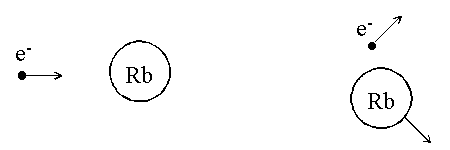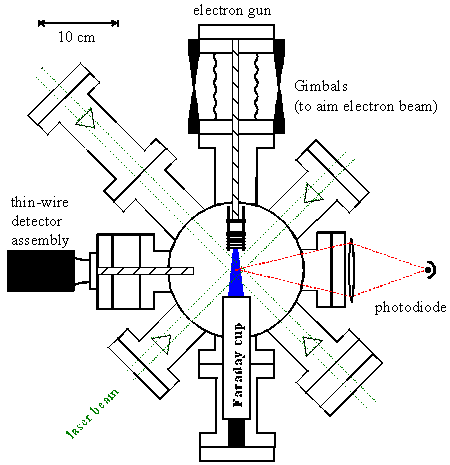IV) Laser-Cooled Trapped Atoms for electron scattering Cross Sections
A. Introduction
So far, we have consider only cross sections measured by the Optical Method. That is, we have measured the new levels populated in the target atoms after an electron-atom collision. Another example of studying the newly created target states is the measurement of the ions produced in ionizing collisions.Principles
There is a whole other way of measuring electron scattering cross sections that we have not yet discussed. Instead of measuring the new things you create, you measure the loss of the things you start with. There are two ways of doing this. You can measure the attenuation of the electron beam as is passes through a fixed length of a gas target at a known pressure. Or you can measure the loss of atoms from a beam or other fixed target.
Our atom trap experiment is a case of this second approach, an electron beam hits a small ball of trapped rubidium atoms. We measure the fractional loss of atoms in the trap to obtain the total electron scattering cross section (elastic, inelastic, ionization..).

Conceptually, this is a very clean experiment. The absolute atom number density is not needed, only the fractional loss of atoms in the trap. However, forward scattering (very small recoil) requires special care.
Description of MOT Experiment
We use a laser-cooled magneto-otical atom trap. Without getting into the details of trapping (a subject better left to others), the experiment works as follows:To trap atoms:
- Inhomogeneous magnetic field: Center B=0, gradient=/=0
- Six diode laser beams slightly detuned from Rb(52S1/2-->52P3/2), 780 nm
- Yields:
- Trap atoms form a ball ~1/2 mm diameter, laser beams catch atoms within ~1 cm diameter
- typically there are about 106 trapped atoms at temperature of 100 µK
- Number of atoms monitored by Rb (5p-->5s) fluorescence with a photodiode
- Pass electron-beam thru the trap, recoiled atoms escape from trapping volume
- Measure fractional loss of trapped atoms

Only four of the six laser beams are shown. The thin-wire detector assembly is used to measure the electron gun profile.
references:
Electron Collision Cross-Sections Measured with the Use of a Magneto-Optical Trap. R. S. Schappe, P. Feng, L. W. Anderson, C. C. Lin, and T. Walker, Europhys. Lett. 29 (1995) 439-444.
See also Thad Walker's very special Atom Trainer group.
 |
 |
 |